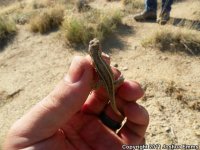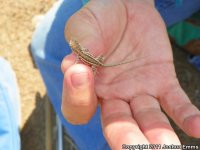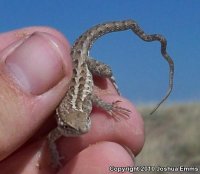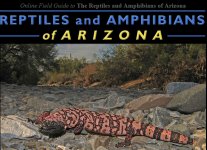| Range: |
 |
| Other Names: |
Side-blotched Lizard |
| Subspecies: |
Eastern Side-blotched Lizard Uta stansburiana stejnegeri Males are often profusely speckled with blue on the tail and posterior body. It averages 85.1 dorsals and fewer than 8 interfemorals.
Plateau Side-blotched Lizard Uta stansburiana uniformis It lacks dorsal markings or has a uniform pattern of dark and light dots. Uniformly small body scales further distinguish it from other subspecies, which have body scales that grade from largest middorsally to smallest laterally. |
| Description: |
A small (up to 64 mm or 2.5" from snout to vent), orange-tan to gray-brown lizard. A dark blue-gray to black blotch marks each lower side of the body just behind the forelimb. Markings are variable and can include brown chevron-shaped blotches, light dorsolateral stripes, no pattern, and speckles. The lips and sides of the throat are often marked with alternating orange and gray to blue-gray stripes. The remainder of the underside is plain pale gray. Males often have bright turquoise blue speckling on the tail, back, and upper surfaces of the hind limbs. Females lack blue speckling and usually have light dorsolateral stripes. The scales on the body are small and mildly keeled. The scales on the tail are larger and more strongly keeled. The belly scales are smooth and flat and the scales on the top of the head are large and smooth. |
| Similar Species: |
Its single side blotch distinguishes this lizard from our other small lizards. External ear openings further distinguish it from the similar looking Earless Lizards. |
| Venom: |
None |
| Habitat: |
The Common Side-blotched Lizard inhabits desertscrub communities, Semidesert Grassland, Interior Chaparral, and Great Basin Grassland. It can be found in a wide variety of terrain types ranging from sand dunes to rocky hillsides. It is usually encountered in relatively open, sunny areas.
|
| Behavior: |
This diurnal lizard can be active at any time of the year but winter activity is usually restricted to sunny, warm days. During the summer it is most active mid morning and late afternoon. It is primarily a ground-dweller that is commonly seen around the bases of small shrubs and on the banks of rocky washes. It regularly climbs onto low rocks and fallen wood to bask. Polygynous, but often seen in male-female pairs. |
| Hibernation: |
|
| Reproduction: |
Multiple clutches of eggs are laid in spring and summer. Clutch size ranges from 2 to 5 eggs. Hatchlings begin to emerge in June. |
| Diet: |
The Common Side-blotched Lizard is an opportunistic forager that waits for prey to wander within close proximity. It feeds on a variety of insects including grasshoppers, beetles, ants, and termites. It also eats a variety of spiders, scorpions, and occasionally some plant material. |
Adapted from account on 


























